Up until 1785 only one narrow lane linked Newcastle's market street (Bigg Market/Newgate Street) with Pilgrim Street. The main reason was the steep dene of the Lort Burn lay between them and a bridge - the High Bridge - was the only way to link them. Both sides of the lane were built up from early times, but there seem to have been few significant buildings, other than in 1766 when the Presbyterians raised High Bridge Chapel and in 1794 when the Cordwainers Company built their stone-fronted hall on the north side. Both have now gone.
The dip in the road outside Nos. 31-37 is where the High Bridge used to span the Lort Burn.
One of the few remaining areas of cobbled streets in the city, it has both a historical charm and the best of the modern world with a range of independent shops.
Description courtesy of Sitelines.
3rd July 2022







High Bridge, nos. 67 to 75.
Pilgrim St, 54-56 Bewick House return. Former Masonic Temple, now offices, shops and club. Built 1894, to the designs of John Johnson, J.K.W. Lowry. Refurbished and converted c1989. Ashlar and brick with ashlar dressings, lead roofs.
Pilgrim Street front, 4 storey. Neo Jacobean style. Large off-centre entrance archway, topped by a broken pediment on brackets. To the left a doorway with a small window beyond, to the right a segment headed doorway with raised keystone, and foundation stone plaque beyond. Above on eitherside, single circular windows topped by winged globes. First floor has 5 Doric pilasters, and a central pair of windows, flanked by single windows all with ashlar surrounds and round headed arches with carved tympanums. Attic floor above has central 2-light, and flanking 2 light windows, with squat panel pilasters supporting an entablature and balustrade with ball finials. The centre has an elaborate carved dormer with shield. To the left a small corner cupola.
High Bridge front, has to the right a continuation of the Pilgrim Street front, 4 storey with similar fenestration, articulated with pilasters and topped by an elaborate gabled blind dormer. Beyond to the left the facade is red and white brick with ashlar dressings. The first 2 bays are 4 storey and the remaining 4 are 2 storey. The ground floor has an entrance to the left and 5 shop fronts. Shakespeare Street front, 4 storey, 3 window front in the Italianate style. Ground floor has a round headed doorway to left with rusticated pilasters supporting a segmental pediment, and to the right a shop front with a further pilaster beyond. Above 3 deeply sunk windows in surrounds with pilasters and rusticated bands. Above 3 round headed windows in square headed surrounds, also with rusticated pilasters. Above again 3 round headed arches and pilasters. Topped by a deep cornice.
Grade 2 Listed. Source: Historic England.




High Bridge, nos. 61 to 65.



High Bridge, no. 59.


High Bridge, Nos. 53 to 57.










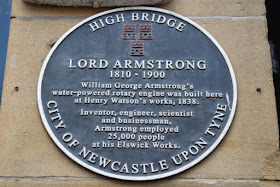


High Bridge, nos. 41 to 51.
Shops and Offices, formerly a hotel extension. 1901-2 Designed by Cackett and Burns Dick. Ashlar with slate roofs and various brick stacks.
3 storey, 9 bays. Central doorway with double panel doors and segmental hood, plus overlight and extremely ornate keystone decoration flanked by stubby Ionic columns. To the left a bar, with central doorway and plate glass windows divided by Ionic pilasters, beyond a goods entrance.
To the right 2 shop fronts with panelled doors. Above an off-centre pair of sashes under a single pedimented hood, with the left 4 pairs, and to the right 2 pairs oil plain sashes, flanked by single plain sashes with bold rusticated surrounds, with double keystones and pediments. Above a moulded cill band, and 7 pairs of small plain sashes with a Doric column between, either side a carved cartouche and beyond single small sashes. Included for group value. The above mentioned buildings were added to the 3rd list in error, by 51st.
Grade 2 Listed. Source: Sitelines.



High Bridge, Lloyds Court.






High Bridge Chambers.

High Bridge Chambers, The Gin Closet.







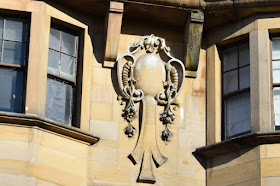



High Bridge, nos. 31 to 39, Ward's Building.
An imposing four-storey property with former warehousing to the rear. Red brick with sandstone detail on the façade.
Building control plans of 1866 show that No. 37 was known as "High Bridge Works". Ward's trade directory of 1881 records that No. 31 was occupied by G. Nicholson, Hatter, No. 35 was occupied by T. Rodham and Co, ale and porter merchants and No. 37 was occupied by E. Wallace, fitter, W. Watson, storekeeper and H. Watson and Sons, engineers.
Goad's insurance plan of 1899 shows that Watson's still occupied Nos. 35 and 37, but the printing firm, H. Ward and Sons owned the rest of the buildings, with machine rooms at the rear, and offices in the frontage building. By 1902 Wards also occupied No. 35 and No. 37 had changed hands six times (including Travers and Sons Limited, tea merchants and Svendsen and Co. importers.
The rear elevation of the frontage building is in white tiled brick. To the rear of Nos. 35 and 39 is a small open yard. No. 37 is a substantial four-storey warehouse, in white tiled brick.
The exteriors of the main building date from the early C20. The façade of the Grade 2 listed Ward's Building dates from 1903. It was designed by James Cackett and Robert Burns-Dick. It is a handsome Art Nouveau commercial building in red brick with ashlar detailing. It has four storeys plus basement and attic with a double panelled doorway. In an elaborate stone surround. On either side are modern shopfronts.
There are four columns of ashlar bay windows on floors 1-3, topped by curved ashlar gables. Slate roof with decorative chimney stacks. Rear elevation is white tiled brick. No. 37 is also of 4 storeys, the main elevations in white tiled brick, contemporary with the rear elevation of the Ward's Building. Grade 2 Listed. William Armstrong built a rotary engine powered by water at his friend Henry Watson's High Bridge Works in 1838.
Source: Sitelines.



High Bridge, no. 24.






High Bridge, no. 23.
No 23 was constructed between 1886-1898 (more likely closer to 1886) replacing earlier buildings. It is difficult to recognise in the trade directories due to renumbering and demolition of buildings on the street. Fire Insurance Plans of 1927 state that the building was in use as a clothing warehouse. The ground floor may have originally functioned as a shop as the present shop front appears original. A number of original features, including a fireplace, exist on the first floor.
Source: Sitelines.




High Bridge, no. 18, The Duke Of Wellington.



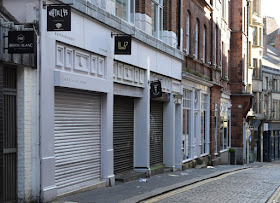
High Bridge, nos. 15-21.
No 15-21 appears to have been built c.1927 - replacing earlier buildings. They appear in Ward's directory 1928 as High Bridge House. (In earlier trade directories No. 15, 17, 19 and 21 are listed either seperately or in pairs).
By 1938 it had eleven occupants engaged in various trades including carpet manufacturing, warehousing and retail. This building is of Art Deco style and is 6 storeys in height with a flat roof. The main entrance into No.21 bears a black marble plaque with 'High Bridge House' written in white. Two small granite steps lead up to the door the first of which also bears the name 'High Bridge House'.
Internally the building has lost the majority of its internal fixtures and fittings. Several stud partition walls have been inserted to create office space and openings have been created between this and adjoining buildings at first and second floor level.
Source: Sitelines.


High Bridge, no. 14.

High Bridge, no. 13.

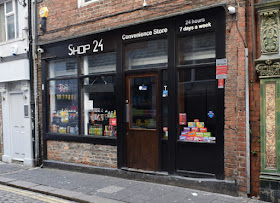
High Bridge, nos. 4-6.
Late eighteenth century or early nineteenth century. A four storey brick house with a plain upper floor, sliding sash windows and blind window on the second floor. The first floor windows have been shortened. The top stone cornice has been replaced with a modern plain gutter and fascia.
Source: Sitelines.


High Bridge Square.

High Bridge Square, no. 2.




High Bridge Square, entrance to The Old George Yard.
See my Cloth Market page for more photos of The Old George Yard.



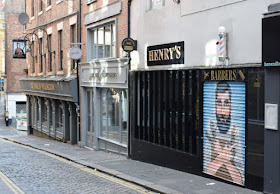



8th May 2022



The Bacchus, 42-48 High Bridge.
24th February 2018
Western end from Grey Street to the Bigg Market.
Eastern end from Grey Street to Pilgrim Street.
29th March 2016
22nd August 2005
More Information:
- Sitelines: High Bridge (street)
- Sitelines: Newcastle, High Bridge
- Co-Curate: High Bridge
- Sitelines: High Bridge, Duke of Wellington Public House
- Sitelines: 4-6, High Bridge
- Sitelines: 15-21, High Bridge
- Sitelines: 23, High Bridge
- Sitelines: 25-29, High Bridge
- Sitelines: 31-39, High Bridge, Ward's Building
- Sitelines: 39, High Bridge, well
- Sitelines: 41-51, High Bridge (The Lane)
- Historic England: 41-51, High Bridge
- Sitelines: High Bridge, retaining wall
Historical interest:
- Sitelines: High Bridge, High Bridge Chapel
- Sitelines: High Bridge, Black Bull Inn
- Sitelines: High Bridge, Cordwainers Company Hall
- Sitelines: High Bridge, Lord Collingwood Inn (New Turk's)
- Sitelines: High Bridge, Reindeer Public House
- Sitelines: High Bridge, Salutation Public House
See my other photos around High Bridge:





























No comments:
Post a Comment